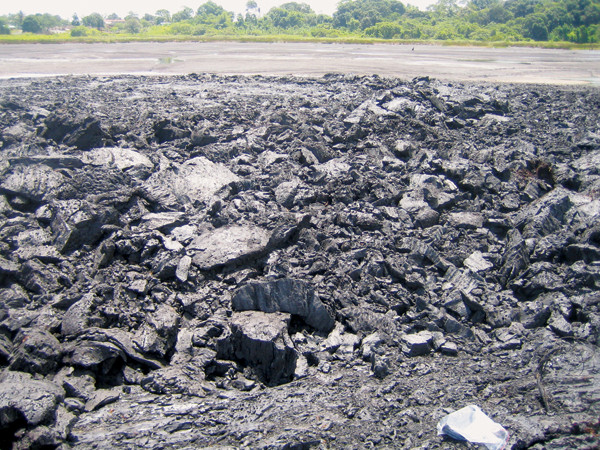
by Timothy Oleson Tuesday, December 9, 2014

Oil rising from underground solidifies into asphalt over much of Pitch Lake on the Caribbean island of Trinidad. In spots, it also reaches the surface as a liquid. Credit: Rainer Meckenstock.
Dark, sludgy oil may not seem like an environment suited to life. But microbes, known to make meals of such organic stews by breaking down large hydrocarbons to extract food and energy, have been found before in petroleum reservoirs. Now, in a new study, researchers report finding diverse communities of microorganisms living inside tiny water droplets in Pitch Lake, the world’s largest natural asphalt seep located on the Caribbean island of Trinidad. The discovery may have implications for industry, scientists say, as well as for our understanding of extreme life.
In 2011, a team led by Dirk Schulze-Makuch of Washington State University reported evidence of bacteria and archaea living in Pitch Lake, where oily asphalt slowly oozes to Earth’s surface from underground deposits. But microbes can’t survive on hydrocarbons alone, so the question became: “How do they make a living in there?” says Schulze-Makuch, co-author of the new study published in Science. Returning to the lake several years later, Schulze-Makuch, lead author Rainer Meckenstock, an environmental microbiologist at Helmholtz Zentrum Munich in Germany at the time of the research (and now at the University of Duisburg-Essen, also in Germany), and their colleagues sampled the site again.
Examining oil from the lake, the researchers noticed lots of microscopic bubbles, just 1 to 3 microliters in volume. Some contained natural gas, whereas others were filled with briny water, which isotopic measurements indicated had also risen from deep underground along with the oil and asphalt.
“The amazing thing was that in each of the water droplets, there was basically a mini-ecosystem consisting of all these different types of microbes,” Schulze-Makuch says. In fact, genetic sequencing revealed that each drop held distinct populations of bacteria and archaea. Additional analyses showed the presence of nutrients like phosphate and ammonia, as well as a range of organic metabolites, indicating that the colonies had all they needed to survive and were actively breaking down hydrocarbons in the oil.
Microbes in confined subsurface oil reservoirs are typically thought “to sit near the bottom of the oil,” in a transition zone between the oil and a layer of water, because they need water (in addition to food and energy) to survive, says Steve Larter, a petroleum geochemist at the University of Calgary who wasn’t involved in the Pitch Lake work. The new study is “quite interesting,” he says, in part because it’s the first time someone has “found organisms dispersed in small droplets of water inside the oil,” not just in a transition layer at the base of the deposit.
The observation that hydrocarbon-consuming microbes can thrive not just in boundary zones around oil deposits but within droplets inside them “has implications for assessing biodegradation of oil reservoirs,” Meckenstock and colleagues noted in the study. It’s important for oil companies to understand the degradation state of oil they might be trying to pump out of the ground “because this defines the quality of the oil [and its] value,” Meckenstock says. “All of a sudden, the whole reservoir has to be considered as a big bioreactor where biodegradation could take place.” The new findings could also shed light on how microorganisms degrade and clean up oil spills on land and at sea.
Even more interesting, Larter says, is what the finding says about transportation of life in the deep biosphere — the abundance of microscopic life teeming within subsurface sediments and Earth’s crust. A longstanding question has been how quickly microbes travel underground, or from belowground to the surface. They’ve been thought to move fairly slowly, even by geologic standards, he says, but this study clearly shows that with a big vertical conduit like an oil seep, “you can potentially move organisms by this mechanism over quite long distances on a geologic timescale.”
Schulze-Makuch, an astrobiologist, says the results could also shape ideas about where to look for potential life on Saturn’s moon Titan, which has hydrocarbon lakes on its surface and possibly an icy ocean of ammonia and water below. “If we see some kind of adaptation tools [in the Pitch Lake microbes] to survive or even thrive in liquid hydrocarbons, then we can get an idea of how organisms on Titan could survive,” he says.
© 2008-2021. All rights reserved. Any copying, redistribution or retransmission of any of the contents of this service without the expressed written permission of the American Geosciences Institute is expressly prohibited. Click here for all copyright requests.